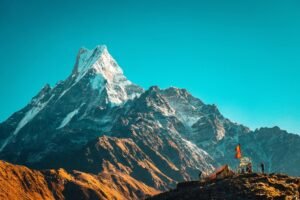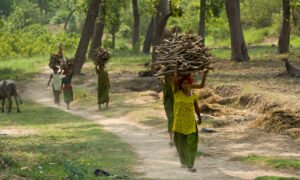The Himalayas, stretching across five countries in Asia, offer some of the most awe-inspiring and challenging trekking experiences in the world. This majestic mountain range is a dream destination for backpackers seeking adventure, breathtaking landscapes, and rich cultural encounters. Whether you’re a seasoned trekker or a novice adventurer, thorough preparation is key to ensuring a safe and enjoyable journey. This comprehensive guide provides essential tips and tricks for backpacking through the Himalayas, helping you make the most of this unforgettable adventure.
1. Research and Plan Your Trip
Choosing Your Route
The Himalayas span across Nepal, India, Bhutan, China (Tibet), and Pakistan, each offering unique trekking experiences. Selecting the right route is crucial for a successful trip.
Nepal: Home to iconic trails like the Everest Base Camp Trek, Annapurna Circuit, Langtang Valley Trek, and Manaslu Circuit. Each of these treks offers a unique perspective on Nepal’s diverse landscapes and cultures.
India: Offers diverse routes such as the Markha Valley in Ladakh, Roopkund Trek in Uttarakhand, Hampta Pass in Himachal Pradesh, and the Singalila Ridge in West Bengal.
Bhutan: Known for its pristine landscapes, Bhutan offers treks like the Snowman Trek, Jomolhari Trek, and Druk Path Trek, which provide a glimpse into the country’s unique culture and natural beauty.
Pakistan: Features the challenging K2 Base Camp Trek and the Fairy Meadows trek, offering unparalleled views of some of the world’s highest peaks.
China (Tibet): Provides remote and spiritually significant treks like the Mount Kailash Circuit and the Everest North Base Camp Trek.
Best Time to Visit
The best time for trekking in the Himalayas typically falls during the pre-monsoon (March to May) and post-monsoon (September to November) seasons. These periods offer stable weather conditions, clear skies, and relatively dry trails, making for safer and more enjoyable trekking experiences. However, some treks, especially those in the lower altitudes, can be undertaken year-round.
Pre-Monsoon (March to May): This season offers warmer temperatures and blooming rhododendron forests, making it an ideal time for treks like the Annapurna Circuit and Everest Base Camp.
Post-Monsoon (September to November):** Known for its clear skies and breathtaking views, this is the best time for trekking. Trails are less muddy, and the visibility of the peaks is at its best.
2. Physical Preparation
Training
Trekking in the Himalayas can be physically demanding, requiring a good level of fitness. To prepare:
Cardio Exercises: Engage in regular cardiovascular exercises such as running, swimming, cycling, or hiking. These activities help build stamina and improve your cardiovascular health.
Strength Training: Focus on exercises that strengthen your legs, core, and upper body. Squats, lunges, and core exercises will help you manage the rugged terrain and carry a backpack comfortably.
Flexibility: Incorporate stretching or yoga into your routine to enhance flexibility and reduce the risk of injuries.
Acclimatization
Altitude sickness is a significant concern when trekking in the Himalayas. Proper acclimatization is essential to reduce the risk of Acute Mountain Sickness (AMS).
Gradual Ascent: Plan your itinerary to include gradual ascents, allowing your body time to adjust to the higher altitudes. The general rule is to ascend no more than 300-500 meters (1,000-1,500 feet) per day above 3,000 meters (10,000 feet).
Rest Days: Include rest days in your itinerary, especially after gaining significant altitude. Rest days help your body acclimatize and recover.
Hydration: Stay well-hydrated by drinking plenty of water. Avoid alcohol and caffeine, as they can contribute to dehydration.
Medication: Consider taking medications like Diamox (acetazolamide) to help with acclimatization. Consult your doctor before starting any medication.
3. Packing Essentials
Packing the right gear is crucial for a successful trekking experience in the Himalayas. Here’s a detailed list of essentials:
Clothing
Layering is key to dealing with the varying temperatures and weather conditions in the mountains.
Base Layer: Moisture-wicking thermal wear to keep you dry and warm.
Insulating Layer: Fleece or down jacket to provide warmth.
Outer Layer: Waterproof and windproof jacket and pants to protect against rain and wind.
Other Essentials: Woolen hat, gloves, sunglasses, and a buff or scarf for added protection against the cold and sun.
Footwear
Invest in a good pair of trekking boots that are well broken in. Proper footwear is essential for comfort and safety.
Trekking Boots: Waterproof and with good ankle support.
Socks: Moisture-wicking socks and liner socks to prevent blisters. Consider carrying extra pairs to keep your feet dry.
Gaiters: Useful for keeping snow and debris out of your boots.
Gear
Backpack: A durable, weather-resistant backpack with a capacity of 50-70 liters. Ensure it has a comfortable fit and adjustable straps.
Sleeping Bag: A high-quality sleeping bag rated for cold temperatures, preferably down-filled for better insulation.
Trekking Poles: Helpful for balance and reducing strain on your knees, especially on steep descents.
Navigation Tools: Map, compass, and a GPS device or smartphone with offline maps.
Headlamp: With extra batteries, for early morning starts or nighttime use.
Other Essentials
First Aid Kit: Include altitude sickness medication, pain relievers, bandages, blister treatment, antiseptic wipes, and any personal medications.
Water Purification: Tablets, filters, or a portable purifier to ensure safe drinking water.
Snacks: High-energy snacks like nuts, dried fruits, energy bars, and chocolate to keep your energy levels up during long trekking days.
Personal Items: Sunscreen, lip balm, toiletries, a multi-tool, and a camera or smartphone for capturing memories.
4. Understanding Local Culture and Customs
Respect Local Traditions
The Himalayas are home to diverse cultures, languages, and religions. Respect for local customs and traditions is essential.
Greetings: Learn basic greetings and phrases in the local language. For example, in Nepal, “Namaste” is a common greeting.
Religious Sites: Remove your shoes before entering temples and monasteries. Be respectful when taking photographs and avoid pointing your feet at religious objects.
Dress Modestly:Wear appropriate clothing, especially in villages and religious sites. Avoid wearing revealing clothes.
Permits and Regulations
Different regions in the Himalayas have specific permit requirements. Ensure you have all necessary permits before starting your trek.
Nepal: Trekkers Information Management System (TIMS) card and various conservation area permits (e.g., Annapurna Conservation Area Permit, Sagarmatha National Park Permit).
India: Inner Line Permits for certain regions in Ladakh, Sikkim, and Arunachal Pradesh. Check with local authorities for specific requirements.
Bhutan: All treks must be arranged through a licensed tour operator. Trekking permits and a daily fee are required.
Pakistan: Special permits are required for trekking in certain areas, such as the Gilgit-Baltistan region. Ensure you have the necessary documentation.
5. Safety and Health
Staying Safe
Safety should be your top priority when trekking in the Himalayas.
Weather Awareness: Mountain weather can change rapidly. Be prepared for sudden changes and always have an alternative plan. Check weather forecasts regularly and be aware of potential hazards like avalanches and landslides.
Group Travel: It’s safer to trek in a group. If you’re solo, consider hiring a local guide or joining a trekking group. Guides can provide valuable insights into the terrain and culture.
Emergency Services: Know the location of the nearest medical facilities and have a plan for emergency evacuation. Carry a satellite phone or a personal locator beacon (PLB) for emergencies.
Health Precautions
Maintaining good health is crucial for a successful trek.
Vaccinations: Ensure you’re up to date on necessary vaccinations. Consult with a travel health specialist for recommendations based on your destination.
Hydration: Drink plenty of purified water to avoid dehydration. Use water purification tablets or filters to ensure safe drinking water.
Food Safety: Eat freshly cooked food and avoid raw vegetables and unpasteurized dairy products. Carry energy bars and snacks for sustenance on the trail.
Personal Hygiene: Maintain personal hygiene to prevent illness. Use hand sanitizer and avoid sharing utensils or water bottles.
6. Environmental Responsibility
Leave No Trace
Preserving the pristine environment of the Himalayas is crucial for future generations of trekkers.
Waste Management: Pack out all non-biodegradable waste, including plastic bottles and packaging. Use biodegradable soap and toothpaste to minimize environmental impact.
Campsite Etiquette: Camp only in designated areas and avoid disturbing wildlife. Follow the principle of “leave no trace” by cleaning up your campsite and disposing of waste properly.
Sustainable Practices: Use refillable water bottles and avoid single-use plastics. Support eco-friendly trekking practices and initiatives.
Supporting Local Communities
Supporting local communities not only enhances your trekking experience but also contributes to the local economy.
Local Guides and Porters: Hiring local guides and porters provides employment opportunities and supports the local economy. Ensure they are paid fairly and treated with respect.
Buying Local: Purchase supplies, souvenirs, and services from local businesses. This helps boost the local economy and fosters positive relationships between trekkers and local communities.
7. Enjoying the Journey
Immerse Yourself
Take time to appreciate the stunning landscapes, diverse flora and fauna, and the serene environment of the Himalayas.
Photography: The Himalayas offer incredible photo opportunities. Carry a good camera and extra batteries. Be respectful when photographing people and always ask for permission.
Cultural Exchange: Engage with the local communities and learn about their way of life. Participate in cultural activities and try local cuisine to enrich your experience.
Mindfulness: Trekking in the Himalayas can be a spiritual experience. Practice mindfulness and be present in the moment. Reflect on the journey and the natural beauty surrounding you.
Personal Reflection
Trekking in the Himalayas is not just a physical journey but also a personal and spiritual one.
Journaling: Keep a journal to document your experiences, thoughts, and feelings. Reflecting on your journey can provide deeper insights and lasting memories.
Connection with Nature: Take time to connect with nature. The tranquility and beauty of the Himalayas offer a unique opportunity for introspection and spiritual growth.
Backpacking through the Himalayas is a once-in-a-lifetime adventure that requires careful planning and preparation. By following these essential tips and tricks, you’ll be well-equipped to handle the challenges and fully enjoy the breathtaking beauty and rich culture of this remarkable region. Remember to respect the environment, the local communities, and your own physical limits. Happy trekking!
Further Reading and Resources
Books: “Trekking in the Nepal Himalaya” by Lonely Planet, “Into Thin Air” by Jon Krakauer, “Himalaya” by Michael Palin.
Websites: [Nepal Tourism Board](https://www.welcomenepal.com), [Himalayan Trekkers](https://www.himalayantrekkers.com), [Trekking in India](https://www.indiahikes.com).
Forums: [TrekEarth](http://www.trekearth.com), [TripAdvisor](https://www.tripadvisor.com), [Reddit Hiking and Backpacking](https://www.reddit.com/r/hiking/).
This guide aims to provide a comprehensive overview to help you prepare for an unforgettable Himalayan trek. Always tailor your plans based on specific routes and current conditions, and seek advice from experienced trekkers and local guides.





